Arizona shares a border and desert with Mexico and an interesting history of agave spirits
The demand for Mexican spirits has grown exponentially in the US and abroad. While tequila still dominates the market, one of the most exciting developments has been the celebration of regionality that we’re seeing today. Pox from Chiapas, Raicilla from Jalisco, Sotol from northern Mexico and other spirits that were once hard to find outside their region of production are now finding their way onto back bars and liquor store shelves and are sought after by increasingly educated and curious consumers.
In Arizona, there’s been a resurgence of bacanora, lechuguilla and palmilla (the term for sotol in Sonora) produced in the northern Mexican state of Sonora. I say resurgence because, bacanora and other agave distillates were almost as common as whiskey on the shelves of saloons in southern Arizona before their prohibition in 1915 by the then governor of Sonora, Plutarco Elías Calles– a prohibition that lasted until 1992. And not only were they imported, but agave spirits were also produced in Arizona, including the only “tequila” ever made outside of Mexico.
But man’s relationship with agave dates back thousands of years before Filipino sailors brought asiatic stills on the Manila galleons to the west coast of what is now Mexico, and the Spanish brought copper alembic stills from Europe. On a trip to Tucson for the Agave Heritage Festival, I spent some time with Doctors Paul and Suzy Fish in an ancient Hohokam agricultural field that dates to the beginning of the classic period (1000-1360 CE) for the cultivation of agave at the base of Tumamoc Hill. Archeologists have dated the cultivation of agave in this area as far back as 500 CE. To the untrained eye, it looked like any other Sonoran desert landscape. But under their guidance, you could begin to see signs of human intervention in the landscape. Piles of rocks formed terraces and created dam along with other piles in which agaves were planted that helped to prevent evaporation in the scorching desert heat.




The Hohokam were irrigators par excellence as evidenced by the canal systems built off the Salt River that early Anglo settlers used and expanded upon in the area that became the city of Phoenix. But here they were utilizing run off irrigation from infrequent and often intense rainstorms, thus having to both prevent erosion and preserve moisture for as long as possible. They were cultivating Agave murphyi (as well as other species in other regions) for use as food, rope and textiles made from the fibers and also fermentation. Also found are the remnants of agave roasting pits identifiable by ash mixed with the soil and stones that had been affected by intense heat, along with stone tools used for cutting the leaves off and processing the agave once it had been cooked. Once roasted, the trunk or heart of agave (known as the piña in Mexico due to its resemblance to a pineapple when the leaves are removed) and its inflorescence become a delicious and nutritious food source. They would also squeeze the juice, now rich in fermentable sugars, from the fibrous hearts and ferment it into what became known as “mezcal wine”. While they are both fermented agave based drinks, mezcal wine is different from pulque because the agaves are cooked.
A quick note about the word mezcal. It derives from the Nahuatl word mexcalli which is the combination of the word for agave (métl) and cooked (ixcalli). It was the colloquial name for the agave plant and the spirit produced from it and was commonly spelled with an s instead of a z in regions where English became the dominant language. It was used for many place names in Arizona and the Mescalero Apache were named such because of their fondness for the plant as a food source and for ceremonial use. I will spell it with an s when quoting historic sources or place names. Otherwise, it will be spelled properly with a z, as it is in Mexico.
The production and consumption of mezcal wine was widespread up until European contact when distillation technology virtually wiped it off of the map, however, it was far from the most important alcoholic beverage being made by the indigenous population. Others were made from corn and were called tesgüino or tejuino in Mexico and tiswin by the Apache;, tunas or prickly pears known as colonche in Mexico mesquite pods; pitahya or pitaya, which refers to the fruit of several species of cacti, but for our case refers to the fruit of lemaireocereus thurberi or the organ pipe cactus and the sacred “wine” made from the fruit bahidaj of the saguaro (carnegiea gigantea) the Tohono O’odham know as navai’t, which is still ceremonially prepared and consumed to this day to ensure a robust monsoon season. All of these held a far more important place both ritually and ceremonially in most of the various tribal groups throughout the region.
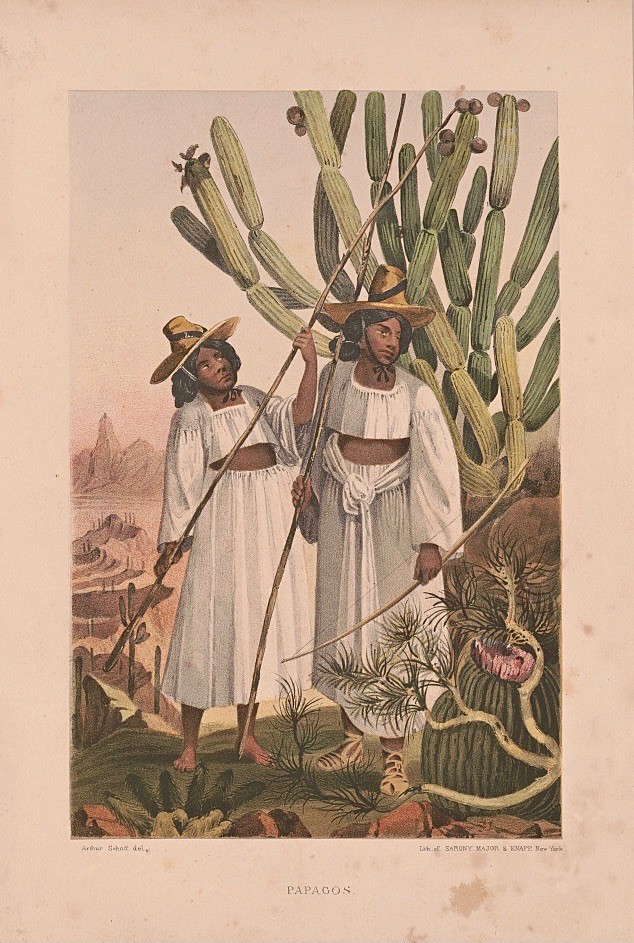
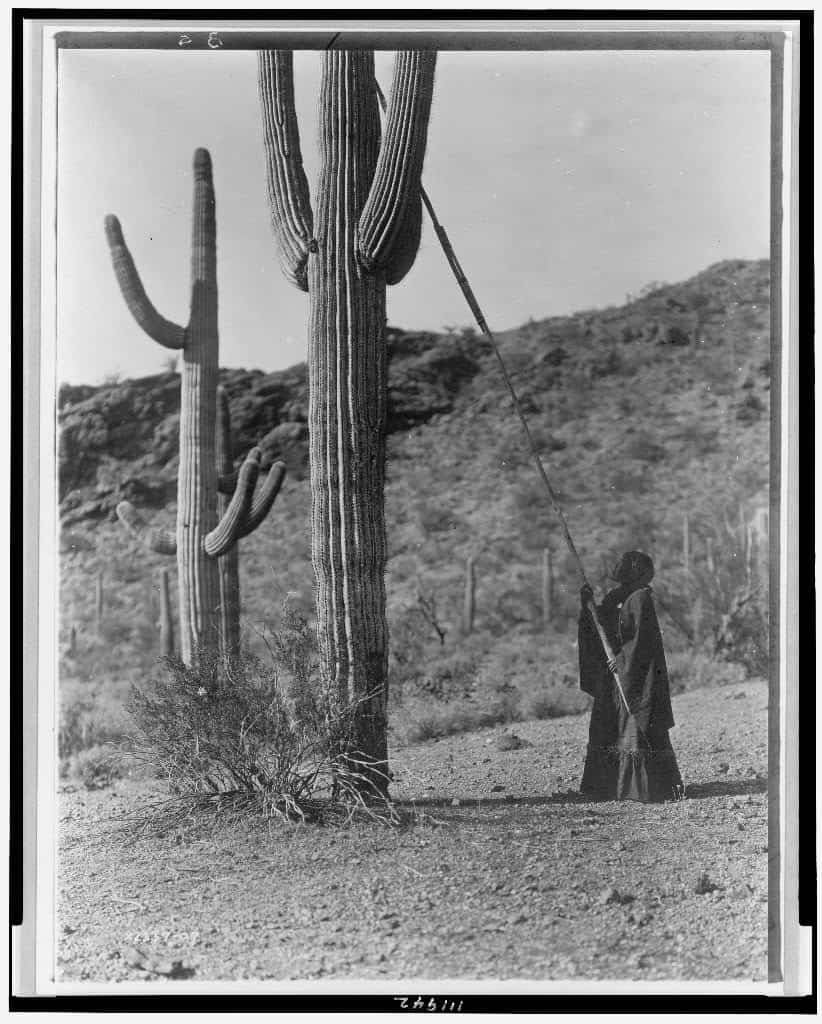
Bacanora and other spirits of Sonora
Distillation technology spread quickly after European contact,and was adapted for use with plants endemic to the continent, namely agave and dasylirion (sotol). The Ópata and other indigenous groups in what is now Sonora were no exception. Of note, although there is some evidence of pre-European distillation such as the “Capacha stills” from from Colima, if distillation did occur it was highly localized and probably ritualistic in nature.
The town of Bacanora,derived from the Ópata words bac which means reeds and noraco which means hillside, has given its name to the most famous of the Sonoran distillates. It has been produced for approximately 300 years and although originally it would have been made from several species of agave, now it is produced solely from A. angustifolia haw, known colloquially as pacifica or yaquiana. In 2000 it was awarded a Denominación de Origen (DO) which protects it as an exclusively Sonoran product and includes 35 municipalities. Like other Mexican DOs, some feel it is problematic and that it has embraced commercial expansion and industrialization of the category over protecting traditional methods of production and the producers who use those methods.
Bacanora was well known to the people of Tucson and elsewhere in southern Arizona and had distinguished itself from other agave spirits there in the 19th century. Other spirits produced in Sonora are “lechuguilla” made mainly with A. bovicornuta and A. shrevei and “palmilla” made from the dasylirion or sotol plant. Sotol has a DO for the Mexican states of Chihuahua, Coahuila and Durango, thus they call it palmilla, the local colloquial term. As mentioned earlier in the article, the production of spirits was outlawed in Sonora in 1915, though as with prohibitions elsewhere, production never ceased, but moved into remote areas away from government eyes.

One holdover from its long prohibition is the common use of modified 50 gallon oil drums as stills. These were cheap and easy to get as well as far more inconspicuous than copper stills should the authorities come around. Prohibition of spirits in Mexico,and Nueva España before, was not unusual and occurred throughout its history for reasons of competition with imported spirits or morality. Pancho Villa himself was a teetotaler,he preferred strawberry soda and ice cream to tequila and cerveza, who prohibited alcohol production and even the soldados of the fearsome División del Norte from imbibing themselves.
Agave Spirits in Pre-Statehood Arizona
That agave spirits were produced in what is now Arizona should not be a surprise to anyone; up until the Treaty of Guadalupe Hidalgo in 1848 and the Gadsden Purchase in 1854 what is now the state of Arizona was part of Mexico. Arizona has species of agave that are endemic to it that are suitable for distillation. And the flora and fauna of the great Sonoran desert that both Sonora and Arizona share do not recognize the imaginary boundaries that man imposes on the land. Still, evidence of it is almost non-existent except for some mentions in archives of newspapers and a few other sources. Perusing these, you mostly find references to the smuggling trade as you would expect.
Even before prohibition, there was quite a lot of smuggling going on to avoid taxation. There was also the illicit manufacturing of mezcal on the American side. So much so that according to a mention in the Arizona Citizen on February 18, 1871, “After opening, Mr. Goodwin presented a memorial to Congress asking a modification of the excise law so as to permit free distillation of Mescal liquor; afterwards passed unanimously.” Others were engaged in the legitimate importation and sale of spirits to quench the never ending thirst of early Arizonans. Of these, Julius Goldbaum was one of the most enterprising. One of seven children of immigrants from Prussia, Julius was born in 1861 in Denver, Colorado. In 1877 Julius moved to Tucson and worked as a bartender at the Park and then at his uncle’s establishment, the Gem Saloon. He bought his first saloon in 1885 and named it “Jule’s Club Saloon” on Church Plaza. Not long after he moved it to Congress St. Julius was not a distiller himself, although it’s said that in 1888 he bought the building that now houses Old Town Artisans at 201 N Court for use as a distillery and residence.
To my knowledge, no evidence of it actually being a distillery exists. He was what was known as a “rectifier”, blending raw whiskey he bought in bulk from distilleries in Kentucky and elsewhere and bottling them under several brands that he created for resale. Here Mr. Goldbaum really shows his propensity for graphic design and promotion, having created several beautiful “back bar” bottles and labels that are prized today by collectors. Included in these is his label for his “Mescal Bacanora” with its lush chromolithograph representation of an agave in bloom. This label puts his establishment at the corner of Meyer and Congress streets. He was also an early importer of tequila which at that time was called “Mescal de Tequila” and there is a label in existence from 1895 along with a several newspaper advertisements for “Mescal Bacanora por galon y botella” (El Fronterizo. August 20, 1892). In this respect, he was what’s known as a “bottler”, one who may bottle blends of the same spirit bought in bulk but not adding additional ingredients or treatments to change the character of the spirits.




Although Goldbaum was one of the most prolific of southern Arizona’s liquor men, he was hardly the only one. Jesus Provencio offered “El Famoso Mezcal Bacanora” at his Mascota Saloon. The Two Nations Saloon advertised “Mexican Cigars and Bacanora Mescal” and “The best mescal in Tucson; a pure, unadulterated article at $4.50 a gallon at Zeckendorf Bros.” And Antonio Zepeda advertised “Legitimo Mescal” at his Casino Saloon along with Sam Gillespie who touted his importation of tequila which he claimed was “the best liquor in the world for medicines” (The Arizona Sentinel, December 13, 1890). The J. Guindani & Co., a general store in Florence, AZ also was advertising “Imported Mescal” in 1877. Anton Hittinger was another pioneer and prominent businessman in Tucson who opened his liquor store in 1881 and later operated it under the name “Tucson Liquors” until 1899. He was also a rectifier and importer and advertised his “Imported Chihuahua and Sonora Mescals”. A mention in the Arizona Weekly Citizen on March 29, 1890 declares, “Rumor has it that A. Hittinger of Tucson contemplates opening a mescal distillery in this city. As much of the mescal plant used by the distillery on the Sonora side is shipped from the American side he thinks he can make money by manufacturing the article in the United States.”
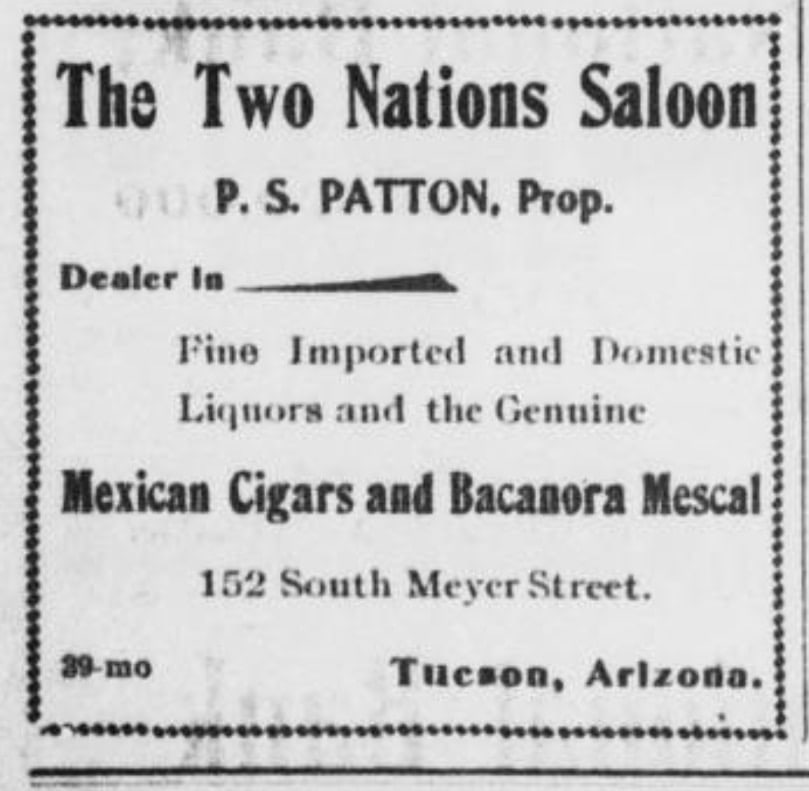

Aside from the mention of an Anglo thinking about starting a mezcal distillery, this is extraordinary in that it says agave were actually being exported to Sonora to produce mezcal there. Another article titled “A Home Industry” from the Tombstone Epitaph, April 26, 1891 states, “Tombstone is to have a mescal distillery. When complete it will furnish a sufficient amount of that beverage called pulque to meet the demand, in Arizona at least.” And, “The plant, which grows to perfection in Cochise county, furnishes a distillery in Sonora with most of its raw material for making the liquor. There is no doubt but some day mescal will become a popular drink all over the United States.” Here, is another mention of agave being exported to Sonora for production. As in the case of Goldbaum, there’s no evidence of any of these distilleries actually being built or producing agave spirits. In fact I couldn’t find any instances of Anglos actually making agave spirits, illicitly or legitimately, until the 20th century.
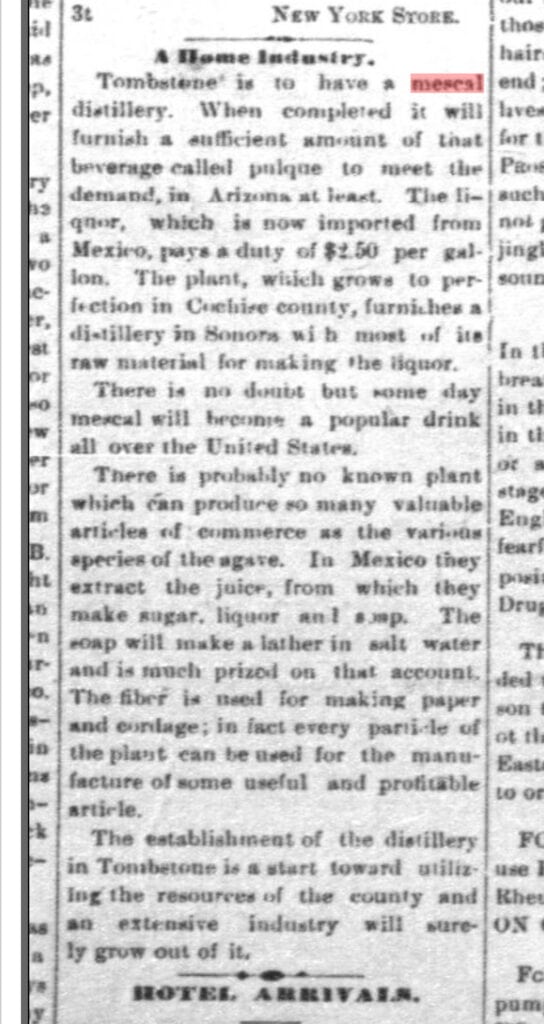
Additionally, there are academic journals that verify the making of agave spirits in Arizona. In “The Agaves of the United States” (A. Isabel Mulford, 1896), there’s a quote from Professor James W. Toumey, the noted botanist and educator, “By fermenting and distilling its juice the Indians make their drink called “Mescal,” which is very intoxicating, casting all records attributed to “Jersey lightning,” most completely in the shade.” Next there’s an excerpt from a letter of his that describes an encampment of Pepago (sic) Indians in the Catalina Mountains for the purpose of making “Mescal” from A. palmeri. Later in the booklet Dr. Timothy Erastus Wilcox, who was the post surgeon at Ft. Huachuca, AZ from 1891-1895 and who made botanical collections for the Herbarium of Columbia College in his spare time, states that “after making many and careful inquiries he is convinced that A. palmeri is the only species used in Arizona for food or for making the liquor Mescal.”

Although it is incorrect that Agave palmeri was the only agave to be used as food and distilled, these and numerous newspaper reports of “mescal camps” and their descriptions of those who worked them were unanimously Mexican nationals and indigenous peoples. Not to mention the hundreds of years of distillation history by these groups in Sonora and throughout Mexico. I did, however, uncover a tragic incident that centered on a “mescal camp” in the Sonoita Valley. Apparently after the murder of a Mr. Byrd by two Mexican nationals who fled the country, a vigilante group of about six or seven men was formed and set about going from ranch to ranch chasing off the Mexicans employed at them with their families under threat of death. On May 9th, 1859 they came upon a mezcal distillery where several Mexican and Yaqui men were employed in a “peaceable and legitimate manner” in making mezcal. At the sight of the armed group the men at the distillery fled, at which time they were fired upon, killing three Mexicans and a Yaqui instantly and mortally wounding another Mexican.
The repercussions of the killings were devastating to the ranching and mining interests in southern Arizona, both of which depended heavily on Mexican labor as they fled en masse south to Sonora. The leading citizens of southern Arizona took out a full page ad in English and Spanish condemning the murders, chastising those who committed them as cowards and outlaws and promising all aid to the soldiers at Ft Buchanan under the command of Lt Col Reeves. They also guaranteed the safety of those who should wish to return and that both American citizens and the United States troops would protect them.
The vigilante group was headed by a man named William Ake who had a ranch just north of the mezcal distillery on Sonoita Creek. Most of the group were quickly caught and sent to trial in Santa Fe. Ake was last seen around Ft Yuma heading west, and it’s unknown if he was ever apprehended or punished. Strangely enough, another tragedy happened right after the massacre when a cart loaded with barrels of mezcal was ascending a hill and the barrels broke loose, “passing over a poor Indian woman who was walking behind, crushed her to death” (The Weekly Arizonian, May 26, 1859) and injuring a Mexican woman who was taken to the same William Ake’s house and nursed back to health by his family.
After the Turn of the Century
Prohibition came early to the newly minted state of Arizona. On January 1st, 1915 the importation, manufacturing or selling of alcohol was prohibited. Even though there was a prohibition in Sonora as well, the authorities mostly turned a blind eye to the cantinas in border towns catering to gringos heading south for a drink. As bacanora production went clandestino, tequila was still coming north via rail to be smuggled into the country. And Tucson was a major distribution center for it. According to historian Ted Genoways, who’s writing a book on the history of tequila, it was supplied to boarding houses where a spare bedroom could be rented for the night and a bottle would be left out in the kitchen. These became known as “tequila kitchens”. When national prohibition was repealed in 1933, a group of entrepreneurs was waiting in the wings to build a tequila distillery in Southern Arizona. .
On June 6th in 1936, the first barrel of tequila made in the United States was produced at the San Andres Distillery in Nogales, AZ. The distillery closed a few years later, but the Pimeria Alta Museum in Nogales has photographs and architectural drawings of the distillery, and even photos of the first barrel made, complete with an agave piña on top.
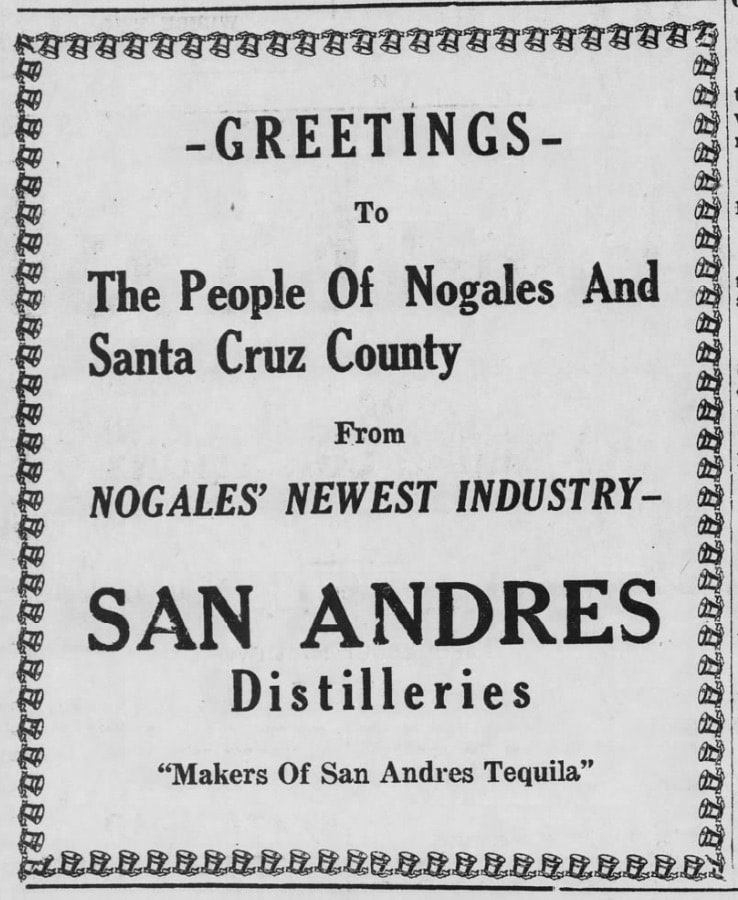



The Denomination of Origin for Tequila was created in 1974. It was the first of its kind outside of France and protected tequila as a distinctly Mexican product, regulating where and how it was to be made. In 1995, Mezcal received its DO, and as mentioned previously, Bacanora in 2000. These names all belong to the Mexican government and are recognized by international treaties, so anything produced outside of the DO’s has to be labeled as an agave spirit.
The next time you sip some Bacanora, know you are drinking far more than a spirit. In your glass is a cultural treasure that speaks of the beauty of Sonora and the resilience and ingenuity of her people.



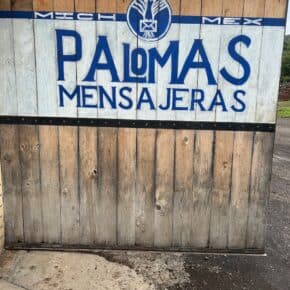








Leave a Comment